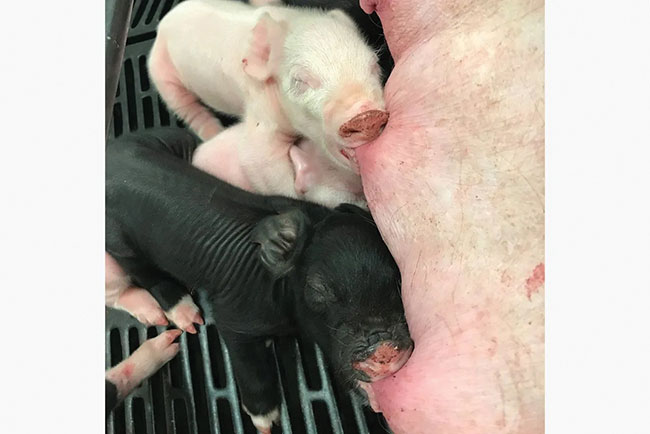
News
Animal Health
More milestones during pig gestation
By Elizabeth Hines, Jayda Chandool, Penn State University
The next key developmental phases, and the influences of feed and housing on healthy pigs
 Pigs born after a gestation period of about 115 days.
Image courtesy of S. Totilo and S. Viebranz, Penn State. Icon: Jongrak / Freepik
Pigs born after a gestation period of about 115 days.
Image courtesy of S. Totilo and S. Viebranz, Penn State. Icon: Jongrak / Freepik In our final swine column of the year, we conclude our exploration of pig fetal development – everything between the attachment of fertilized embryos to the uterus, to the days right before parturition (birth). Generally, the length of time a sow is pregnant, or gestating, is about 115 days, or three months, three weeks and three days. Development is generally separated into five major phases; in the last issue, we concluded the first three phases. In this article, we touch on the final two, with some parting knowledge.
Day 77-90
Final placental expansion begins at Day 77. This is the in-utero hallmark of late gestation, however late gestation is observed on the outside of the sow by visible mammary tissue expansion. At this time, colostrum and milk production is beginning in addition to continued fetal growth. At this time, “bump feeding” may be beneficial. Bump feeding is the practice of increasing the sow’s feed allowance by approximately 1kg/day. This is to help increase the amount of nutrients for sows for the final growth periods of both fetal and mammary tissues. Bump feeding has been shown to increase birth weights; however, it can be expensive and has not been seen to have any effect on final market weight of the piglets. Some believe the small advantage you get is not worth the cost of bump feeding. The benefits of bump feeding is somewhat controversial among swine nutritionists and economists, so producers should consider the economic and production benefits before applying this feed change in their own herd. The benefits of bump feeding might be stronger in sows that are not of ideal body condition going into lactation. So be sure to monitor the body condition of sows throughout gestation.
Day 90-114
These are the last few days prior to farrowing, as piglets are fully developed by Day 90 of gestation, though may not be viable outside of the uterus at this stage. Days 110-115 of fetal development are focused on storing energy for the piglets during farrowing and when lactation begins. In the final stages of gestation, mammary tissue development is being prioritized; milk secretion will indicate farrowing is very close. At this late stage of gestation, loss of piglets is fairly uncommon. Late term pregnancy loss (abortion) can be a result of a physical trauma to the sow prior to farrowing; whereas individual piglets born still (dead) can be a result of trauma to the fetus during the farrowing process. These are different events and are typically unrelated in pig production, as still birth piglets can occur in perfectly healthy sows. Be sure to closely monitor the care of both sows and piglets during the late stages of gestation and farrowing process to minimize losses.
Carefully monitor sows during gestation to be successful
Although reproduction appears simple between breeding and farrowing, there are many times where hormone signaling, tissue development, or survival of piglets can go wrong. The communication that occurs between each gestating sow and developing fetal litter is a complex, yet carefully synchronized event that eventually leads to successful farrowing. Pig caretakers who work to improve their understanding of the developmental stages discussed in this article will better understand what is happening in their herd when reproductive problems arise, and ultimately improve their ability to communicate issues to their veterinarian or other experts in reproduction.
Print this page